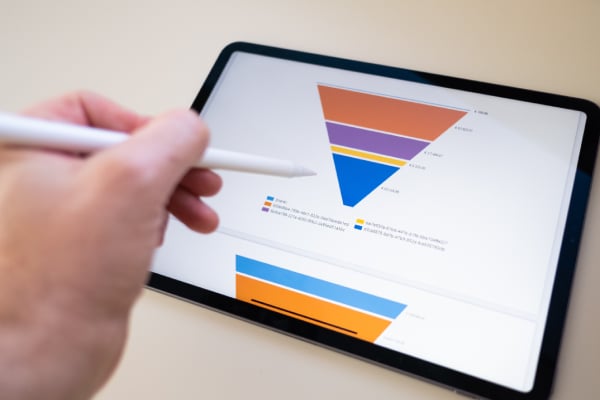In the digital age, consumers are increasingly educated and demanding. Satisfying their needs has become less obvious since the purchasing journey is no longer linear as before.
Companies must therefore implement efficient tools to sustain their activity and gain a competitive advantage . And among these is the sales pipeline , a key instrument for success and a real sales lever.
Have you ever heard of the sales pipeline or sales pipeline ? What is a sales pipeline? Why use a sales pipeline? How to set up a good sales pipeline? Discover in this guide our answers on this sales strategy to improve your sales .
Commercial pipeline definition

The sales pipeline is a sales tool that is used to optimize a company’s sales strategy . This sales process allows you to visualize the sales cycle in detail and chronologically . It lists the different sales opportunities to be seized at each stage. This allows you to:
- Track the progress of your sales;
- Put in place a business action plan to act at the right time and successfully close a deal;
- Proceed with the estimation of the forecast turnover based on commercial performance (probability of realizing a business opportunity);
- Measure the sales performance of each member of the sales team;
- Assess the sales capacity of salespeople.
The sales cycle , let us recall, begins with the initial contact and ends with the purchase of goods or services . In other words, the sales cycle represents the progression of the maturation of prospects along the sales path . In the sales cycle, a person goes from lead status to customer status .
The term ” pipeline ” is of English origin. In the marketing sphere, sales pipeline refers to the sales tunnel or ” funnel ” in English which means funnel.
The sales pipeline is therefore a kind of sales funnel although the two are not exactly the same. At the top, at the entrance, are all the sales opportunities that can be seized. At the bottom, at the exit, are the closed sales. And this is the way the pipeline is visually represented in a CRM software .
Every business has a different sales pipeline because every business operates differently. The sales pipeline depends on the user’s buying journey and the nature of the product or service being sold . Each sales opportunity moves at its own pace. And this depends on the level of interest of prospects or customers.
It may happen that not all the defined sales steps are fully respected. And the process can last more or less time depending on the case. There is therefore no fixed pattern to base it on. It is up to each business leader to manage their business portfolio as best they can .
Why set up sales pipeline monitoring?
As already mentioned, the sales pipeline allows you to evaluate in detail the commercial activity of the company . The sales pipeline gives all the information relating to prospects and customers , the evolution of their status along the sales cycle and the different exchanges that have taken place between the 2 parties.

So you have no difficulty in situating them precisely in the sales process at a given time. Which gives you the possibility of anticipating your actions. The sales pipeline gives you access to sales indicators. These allow you to evaluate your sales performance in advance in relation to a business opportunity and to act accordingly.
If you have, for example, a good sales process, but not enough qualified leads, your sales performance will be reduced . And your sales funnel will automatically be weakened. The same thing happens when you do not accumulate enough traffic on your website . It may therefore be interesting to improve or change your sales prospecting technique to get back on track.
As you can see, by setting up a sales pipeline , you can develop an effective action plan that can help you achieve a higher probability of completion for each business opportunity. And the actions to be taken can relate to the organization, human resources , marketing strategy , etc.
Please note: prospecting is the basis of any business activity. Every business should therefore normally have a well-established prospecting method, but unfortunately, this is not always the case.
If a company does not have a customer database , having a sales pipeline can be a great help. Thanks to it, the decisions made and the actions taken are more thoughtful. Which guarantees better results.
The 5 key stages of a sales pipeline
The sales pipeline is different for every business since the purchasing journey of prospects or customers is not the same.

It also differs from one product or service to another since some are easier to sell than others. The number and nature of the steps that constitute it therefore vary enormously, but broadly speaking, they boil down to:
Step 1: Lead Generation
The buyer becomes aware of his problem or an opportunity to seize. He will then define his needs and requirements, and find out about the different solutions available to him.
He will visit several websites , subscribe to newsletters , download content or register for an event. At this point, he enters the company’s sales funnel as a lead.
Step 2: Qualification
Sales teams assess the likelihood of the business opportunity being realized. They determine the lead qualification level .
How does the prospect behave? How did the first contact with the prospect go? Can the solution proposed by the company really meet their problem?
Step 3: Negotiation
The prospect agrees to an interview or appointment to discuss the proposed solutions . Sometimes, a single appointment is enough to convince him, sometimes several are needed.
Step 4: The proposal
The prospect is interested in the offer and is really thinking about studying it. He will evaluate the product’s ability to solve his problem or exploit the opportunity he wants to seize. The sales manager therefore makes a commercial proposal to the prospect.
Step 5: Closing and concluding the deal
The prospect is considered ready to buy. He is just waiting to be invited to take action. The sales team therefore puts everything in place to make the sale and the transaction a reality.
Note: Each stage of the sales pipeline is associated with a probability of return or a conversion rate. It is the latter that will allow the company to estimate its monthly, quarterly, half-yearly or annual turnover.
See also: Boost your conversion rate with marketing automation
6 tips to improve your sales pipeline
Find below all our tips for having an effective sales pipeline .

1. Update your sales dashboard
To be able to take advantage of all the benefits of a sales pipeline , you need to have a valid and up-to-date database . Otherwise, how could you make an accurate sales forecast?
And this, knowing that this is to be done at the time of the realization and not at the time of the registration of a business opportunity. Let’s suppose that you have planned a turnover of 3,000 euros for the next month. You have sent several commercial proposals to your prospects, but 2 of them have not responded. This non-response is already a lost opportunity .
You have to factor this into your forecast. You’re not going to continue to act as if nothing had happened and hope to make 3,000 euros when 2 transactions have been abandoned.
Updating the business dashboard may consist of:
- Removing prospects who no longer show any interest in the products/services offered by the company.
- The requalification of certain prospects following changes in the genre resignation of one of the decision-makers or delays compared to the initially planned process.
- Reassessing the amount of each business opportunity. If it is too high, it will never be reached. This will have a negative impact on the motivation of the sales teams. If it is too low, the sales teams will tend to overestimate their capacity.
In any case, up-to-date data allows for accurate financial forecasts and therefore precise objectives. Having precise objectives allows for the establishment of an effective and realistic sales prospecting plan .
2. Set a goal for your sales pipeline
As previously stated, it is having objectives that help define the actions to be taken. It is therefore essential to associate an objective with each of the stages of the sales pipeline .
And these sub-goals must all contribute to achieving the overall sales goal . When you set them, keep in mind that it is their precision that will allow you to make the right decisions. You will have no control over your results, but you can put all the chances on your side to get closer to them or even exceed them.
Ideally, choose sales goals , not performance goals. This will bring more dynamism to your sales teams and your sales process . Here are some examples:
- Generate X qualified leads.
- Convert X appointments into opportunities within 2-3 weeks.
- Get X appointments per day.
- Close X sales in 1 month.
3. Know how to prioritize your leads
The number of leads is increasing every day because the company is implementing continuous lead generation systems . And as you know, each lead moves at their own pace in the sales cycle.
It all depends on needs, interest, means, etc. So not all leads should be treated the same. You should prioritize them based on your chances of conversion. Give more time to leads that are more likely to convert.
Set up a lead scoring system and rate your leads. Define scoring criteria: behavior, action, etc. It’s up to you to deduce them from your customers’ actions.
Some of them may, in fact, be constant or similar from one prospect/client to another. Take them into account and use them as a reference to prioritize your prospects.
4. Analyze your salespeople
The software you use (sales prospecting tools, CRM , etc.) allows you to track the progress of your salespeople. They give you statistics on their achievements: number of messages and/or emails sent, number of calls made, number of contracts concluded, etc.
There are even some that offer you a visual representation of their actions within the company. You can thus improve the best, encourage the less good and find a way to make them evolve. For example, you can ask them to work with the best members of the team to better understand how it works.
5. Automate certain actions
To save time and improve performance, automate repetitive and time-consuming tasks as much as possible . If you have built your sales pipeline well, your sales teams will quickly realize what they need to do.
What tasks should they take care of themselves? What tasks can be systematized partially or completely?
6. Know why the sales process failed
In marketing , it’s rare to get it right the first time. Teams go through several failures before finding the best strategy. So you’re going to have to try several methods before you find the one that works best for you.
And this, whether in terms of sales process , prospecting or qualification techniques, lead prioritization, commercial offers, products/services, negotiation techniques, etc.
FAQ – Pipeline commercial
We have come to the end of the article on the commercial pipeline and will continue with the questions and answers section.
What are the KPIs to track with a sales pipeline tool?
4 marketing KPIs allow you to measure the performance of a company’s sales pipeline . These are:
– The amount of transactions: average value of sales;
– The number of transactions: number of qualified opportunities that can be seized in the pipeline;
– The speed with which sales progress: time required for a qualified opportunity to turn into a closed transaction;
– The amount of the pipeline: value of all qualified opportunities in the pipeline.
Sales pipeline and forecasts: what are the differences?
We often tend to confuse sales pipeline and sales forecasts. However, the two do not mean the same thing.
First, the sales pipeline counts all the business opportunities managed by the sales teams. And this, for all stages of the sales process . Sales forecasts, on the other hand, refer to the transactions that can be concluded during a given period.
Second, the sales pipeline allows you to track the evolution of prospects and customers along the sales process .
And this, to better anticipate the actions to be taken. Sales forecasts, on the other hand, allow you to assess the ability to achieve objectives in order to better prepare for them and get back on track if necessary. CRM software such as Hubspot CRM allows you to track both the pipeline and sales forecasts.
How to update your sales pipeline?
Updating a sales pipeline involves:
– Removing prospects or customers deemed useless: those who no longer show any interest in the products/services offered by the company and for whom the chances of conversion are really slim. This is also the case for those who have been inactive for far too long.
– Ensuring the validity of the data: data relating to customers and prospects can change over time. This must be taken into account in order to define an effective action plan when a business opportunity arises.
– Ensuring that the data is accurate: delays and changes noted along the way must be recorded in the process to adjust the forecasts and the action plan.
– Checking that the sales objectives set are neither too pessimistic nor too optimistic: in the first case, sales teams may overestimate their capacity since the objectives are exceeded. In the second case, their motivation will decrease because the efforts made were for nothing.

